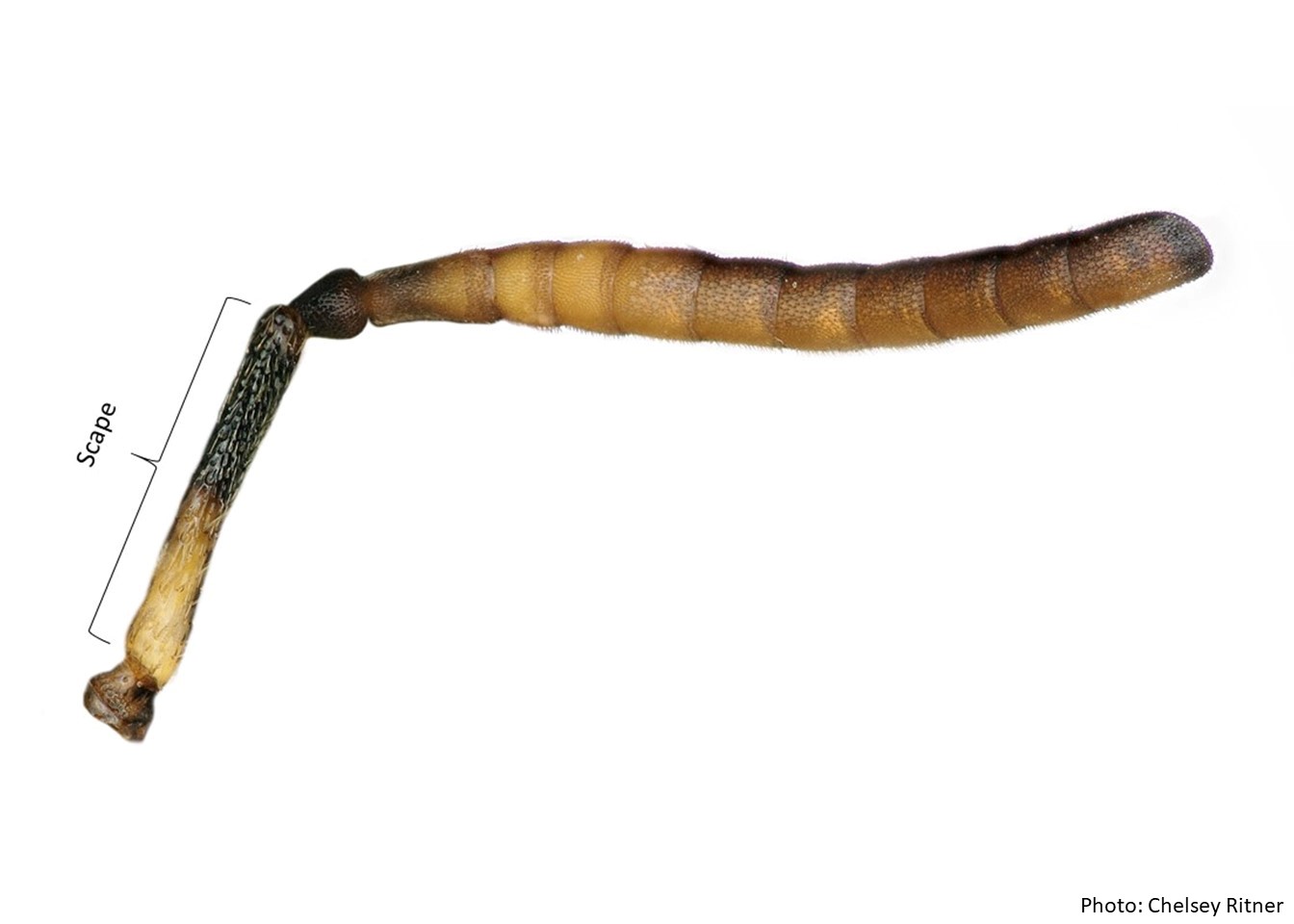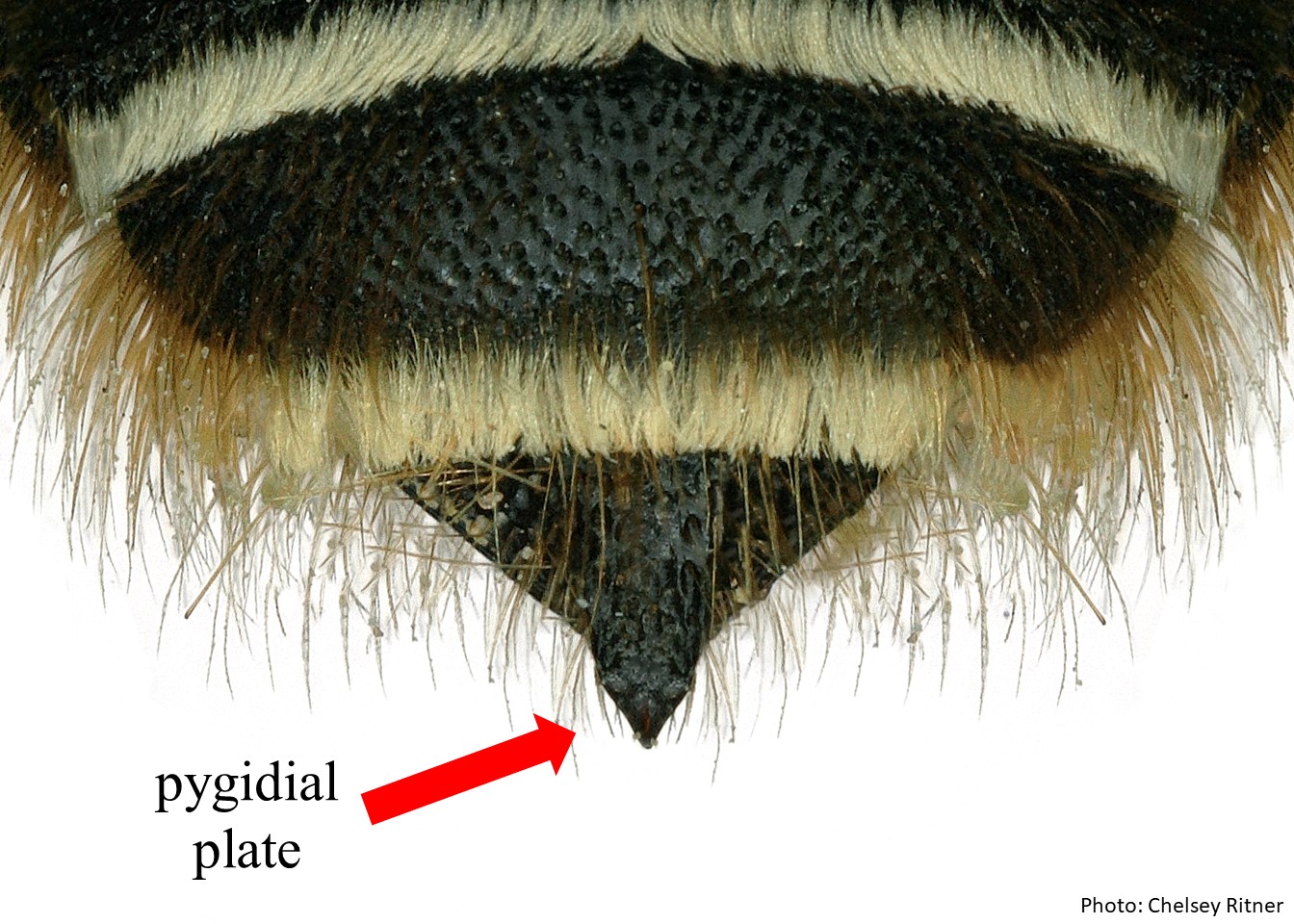Family: Apidae
Subfamily: Xylocopinae
Tribe: Xylocopini
Genus: Xylocopa
Subgenus: Alloxylocopa, Hurd and Moure 1963Hurd and Moure 1963:
Hurd, P.D. and J.S. Moure. 1963. A Classification of the Large Carpenter Bees (Xylocopine) (Hymenoptera: Apoidea). University of California Publications in Entomology (Vol. 29). Berkeley and Los Angeles: University of California Press, 365 pp.
Common name: Carpenter bee
Xylocopa (Alloxylocopa) are large, 20 – 30 mm in length, robust bees, with black integumentintegument:
a tough, protective outer layer
and wings with a faint violet iridescent color. They have white or yellow pubescencepubescence:
short, fine hair
on the thorax that is darker on the underside, and primarily black hair on the rest of their body. Males have pale markings on the base of the mandibles as well as the clypeusclypeus:
a section of the face below the antennae, demarcated by the epistomal sutures, supraclypeal areasupraclypeal area:
the region of the head between the antennal sockets and clypeus, demarcated on the sides by the subantennal sutures, and the scapescape:
the basal, and usually the longest, segment of the antennae (Hurd and Moure 1963Hurd and Moure 1963:
(Hurd and Moure 1963Hurd and Moure 1963:
Hurd, P.D. and J.S. Moure. 1963. A Classification of the Large Carpenter Bees (Xylocopine) (Hymenoptera: Apoidea). University of California Publications in Entomology (Vol. 29). Berkeley and Los Angeles: University of California Press, 365 pp.).
Xylocopa (Alloxylocopa) includes six species (Hurd and Moure 1963Hurd and Moure 1963:
Hurd, P.D. and J.S. Moure. 1963. A Classification of the Large Carpenter Bees (Xylocopine) (Hymenoptera: Apoidea). University of California Publications in Entomology (Vol. 29). Berkeley and Los Angeles: University of California Press, 365 pp.).
Xylocopa (Alloxylocopa) is found natively from Japan, throughout eastern China, and south to Sumatra (Hurd and Moure 1963Hurd and Moure 1963:
Hurd, P.D. and J.S. Moure. 1963. A Classification of the Large Carpenter Bees (Xylocopine) (Hymenoptera: Apoidea). University of California Publications in Entomology (Vol. 29). Berkeley and Los Angeles: University of California Press, 365 pp.; Smith-Pardo et al. 2020Smith-Pardo et al. 2020:
Smith-Pardo, A.H., G. A. Fowler, and S. Kumar. 2020. Status and potential distribution of the Asian carpenter bee, Xylocopa appendiculata Smith (Apidae, Xylocopini), in the United States. Journal of Hymenoptera Research 76: 99-111.). Xylocopa appendiculata was accidentally introduced to California, likely through transported lumber, and now has established populations in Santa Clarita County (Dahlberg et al. 2013Dahlberg et al. 2013:
Dahlberg L., M. Hauser, and D. Yanega. 2013. Japanese carpenter bee, Xylocopa appendiculata Smith 1852 (Hymenoptera: Apidae) potentially established in Santa Clara County, first record for North America. The Pan-Pacific Entomologist 89(4): 226-229.).

Distribution map generated by Discover Life -- click on map for details, credits, and terms of use.
Xylocopa (Alloxylocopa) appears to be a generalist species that visits a wide range of flowering plants including the families of Berberidaceae, Caprifoliaceae, Commelinaceae, Compositae, Elaeagnaceae, Ericaceae, Hippocastanaceae, Leguminosae, Loganiaceae, Oleaceae, Rutaceae, Saxifragaceae, Theaceae, Tiliaceae, and Verbenaceae (Kakutani et al. 1990Kakutani et al. 1990:
Kakutani, T., T. Inoue, M. Kato, and H. Ichihashi. 1990. Insect-flower relationship in the campus of Kyoto University, Kyoto: an overview of the flowering phenology and the seasonal pattern of insect visits. Contributions from the Biological Laboratory, Kyoto University 27: 465-522.).
(Modified from Michener 2007Michener 2007:
Michener, C.D. 2007. The Bees of the World (2nd ed.). Johns Hopkins University Press, Baltimore and London, 953 pp.)
 or spine unarmed.
or spine unarmed.Xylocopa (Alloxylocopa) may be confused with Xylocopa (Xenoxylocopa). X. (Alloxylocopa). Males X. (Xenoxylocopa) are more darkly colored and have foveafovea:
a depressed region of cuticle; in bees this depressed area is usually only very slightly hollow and usually on the face.
on the anterioranterior:
toward the head or on the head side of a segment being described
surface of T1T1:
the segments on the top side of the abdomen, often abbreviated when referring to a specific segment to T1, T2, T3, T4, T5, T6, or T7 . Females lack laterallateral:
. Females lack laterallateral:
relating, pertaining, or attached to the side
spines at the base of the pygidialpygidial:
the terminal part or hind segment of the body
spine (Michener 2007Michener 2007:
Michener, C.D. 2007. The Bees of the World (2nd ed.). Johns Hopkins University Press, Baltimore and London, 953 pp.).
Xylocopa (Alloxylocopa) nest in the dead branches of trees and more generally in dead wood (Hurd and Moure 1963Hurd and Moure 1963:
Hurd, P.D. and J.S. Moure. 1963. A Classification of the Large Carpenter Bees (Xylocopine) (Hymenoptera: Apoidea). University of California Publications in Entomology (Vol. 29). Berkeley and Los Angeles: University of California Press, 365 pp.). There have been multiple accounts of species making nests in the exposed wood of human structures (Maa 1937Maa 1937:
Maa, Tsing Chao. 1937. On Some Carpenter Bees from Eastern Asia (Hym. Xylocopidae) with the Description of one new Variety. The Bureau of Entomology, Hangchow 5(18): 356-367.).
Xylocopa appendiculata is known to be invasive in California where it was first observed in 2012 and again in 2013 in Santa Clara County (Dahlberg et al. 2013Dahlberg et al. 2013:
Dahlberg L., M. Hauser, and D. Yanega. 2013. Japanese carpenter bee, Xylocopa appendiculata Smith 1852 (Hymenoptera: Apidae) potentially established in Santa Clara County, first record for North America. The Pan-Pacific Entomologist 89(4): 226-229.). Other observations were made around the Bay Area. It is predicted that X. appendiculata could establish a population along the entire coast of California as well as on the east coast and the Midwest; however, to-date the species has only been observed in California (Smith-Pardo et al. 2020Smith-Pardo et al. 2020:
Smith-Pardo, A.H., G. A. Fowler, and S. Kumar. 2020. Status and potential distribution of the Asian carpenter bee, Xylocopa appendiculata Smith (Apidae, Xylocopini), in the United States. Journal of Hymenoptera Research 76: 99-111.).
Two males of Xylocopa (Alloxylocopa) phalothorax were collected in Peru in 1879 but no known established populations in that area (Hurd 1978Hurd 1978:
Hurd, P.D. 1978. An Annotated Catalog of the Carpenter Bees (Genus Xylocopa Latreille) of the Western Hemisphere (Hymenoptera: Anthophoridae). Smithsonian Institution Press, Washington D.C. 106 pp.).
Dahlberg L., M. Hauser, and D. Yanega. 2013. Japanese carpenter bee, Xylocopa appendiculata Smith 1852 (Hymenoptera: Apidae) potentially established in Santa Clara County, first record for North America. The Pan-Pacific Entomologist 89(4): 226-229.
Hurd, P.D. and J.S. Moure. 1963. A Classification of the Large Carpenter Bees (Xylocopine) (Hymenoptera: Apoidea). University of California Publications in Entomology 29: 365 pp.
Hurd, P.D. 1978. An Annotated Catalog of the Carpenter Bees (Genus Xylocopa Latreille) of the Western Hemisphere (Hymenoptera: Anthophoridae). Smithsonian Institution Press, Washington D.C. 106 pp.
Kakutani T, T. Inoue, M. Kato, and H. Ichihashi. 1990. Insect-flower relationship in the campus of Kyoto University, Kyoto: An overview of the flowering phenology and the seasonal pattern of insect visits. Contributions from the Biological Laboratory, Kyoto University, 27(4): 465-522.
Maa, Tsing Chao. 1937. On Some Carpenter Bees from Eastern Asia (Hym. Xylocopidae) with the Description of one new Variety. The Bureau of Entomology, Hangchow 5(18): 356-367.
Michener, C.D. 2007. The Bees of the World (2nd ed.). Johns Hopkins University Press, Baltimore and London, 953 pp.
Smith-Pardo, A.H., G. A. Fowler, and S. Kumar. 2020. Status and potential distribution of the Asian carpenter bee, Xylocopa appendiculata Smith (Apidae, Xylocopini), in the United States. Journal of Hymenoptera Research 76: 99-111.